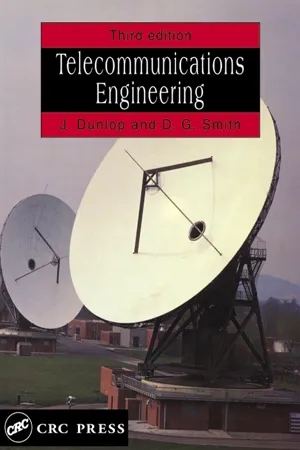
- 593 pages
- English
- ePUB (mobile friendly)
- Available on iOS & Android
Telecommunications Engineering
About This Book
Since the publication of the second edition of this highly acclaimed textbook, telecommunications has progressed at a rapid rate. Major advances continue to occur in mobile communications and broadband digital networks and services, sophisticated signal processing techniques are prevalent at increasingly higher bit rates, and digital systems are widespread. These developments need to be addressed in a textbook that bridges the gap in the current knowledge and teachings of telecommunications engineering.Telecommunications Engineering, 3rd Edition offers an introduction to the major telecommunications topics by combining an analytical approach to important concepts with a descriptive account of systems design. Completely updated and expanded, this third edition includes substantial material on integrated services digital networks, mobile communications systems, metropolitan area networks, and more.What's New in the 3rd Edition
- New chapter on mobile communications covering first generation analog and second generation digital systems
- Expanded chapter on non-linear coding of voice waveforms for PCM
- New section on NICAM
- Updated chapter on the transient performance of the phase locked loop
- Revised chapter on recent major developments in satellite television
- New introduction to coding techniques for burst errors
- Extended chapter on ISDN and broadband digital communicationsSupplemented with worked problems, numerous illustrations, and extensive references to more advanced material, this textbook provides a solid foundation for undergraduate students of electrical, electronic, and telecommunications engineering.
Frequently asked questions
Information
Signals and channels | 1 |
Table of contents
- Cover
- Half Title
- Title Page
- Copyright Page
- Table of Contents
- Preface to the third edition
- Preface to the second edition
- Preface to the first edition
- List of symbols and abbreviations
- 1 Signals and channels
- 2 Analogue modulation theory
- 3 Discrete signals
- 4 Noise in analogue communications systems
- 5 Noise in digital communications systems
- 6 High-frequency transmission lines
- 7. Antennas
- 8 Active microwave devices
- 9 Passive microwave devices
- 10 Telephony
- 11 Television systems
- 12 Optical fibre communications
- 13 Packet switched networks
- 14 Satellite communications
- 15 Mobile communication systems
- Appendix A Four-figure Bessel functions
- Appendix B Useful trigonometric identities
- Appendix C Normal error function
- Appendix D Blocked-calls-cleared (Erlang B)
- Index